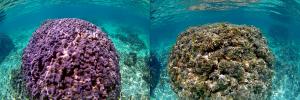Researchers Create First Map Showing Impact on Hawai‘i Reefs
The University of Hawai‘i at Mānoa announces that the first comprehensive map documenting the relative impact of human activities and natural events in slowing reef recovery after extreme coral bleaching caused by rising water temperatures in Hawai‘i, has been produced by an interdisciplinary group of researchers with University of Hawai‘i ties.

Composite showing healthy coral, left, and degraded croal; photo by Keoki Stender, Marine Life Photo
The study, a large, multi-institution collaboration between Stanford University, UH, Stockholm Resilience Center, NOAA, and others, synthesized 10 years of datasets from university and government sources across many factors for the first time to get a big-picture perspective on reef health and regional impacts. It provides a foundation for further research and informs policies to protect coral reefs.
The researchers from the collaborative Ocean Tipping Points project reviewed the data to gauge how a broad suite of factors, such as sedimentation, development and fishing, influence coral reef health across the main Hawaiian Islands.
The study appears in PLOS One and reveals variations in what was inhibiting reef recovery across the islands. On the densely populated island of O‘ahu, for example, the dominant stressors were human activities, such as fishing and loss of natural habitat to coastal development. Sedimentation and nutrient runoff were dominant forces on less populated islands.
“When we jumped into the water in West Hawai‘i, over half of the coral reef was dead,” said the paper’s lead author, Lisa Wedding, a research associate at Stanford University’s Center for Ocean Solutions and graduate of UH Mānoa’s geography PhD program. “These are some of Hawaiʻi’s most vibrant coral reefs, so we were heartbroken—and determined to better understand how reef ecosystems could be more resilient in the future.”
“This area of research has been a long-term need for coral reef conservation and management,” said co-author Joey Lecky, a NOAA GIS analyst who analyzed human drivers of change in the main Hawaiian Islands as part of his graduate work at UH Mānoa’s College of Tropical Agriculture and Human Resources. “These findings will allow us to take a big step forward in understanding how corals are impacted by both human activities and environmental stressors, in a place with incredible value.”
The research team’s findings highlight the importance of tailoring strategies based on location to effectively address local impacts. “These layers are being actively used in the ongoing state effort to meet Gov. David Ige’s 30×30 goal—protecting 30% of the nearshore by 2030—announced at the World Conservation Conference here in 2016,” noted Kirsten Oleson, Lecky’s advisor in the Department of Natural Resources and Environmental Management and a contributing author.
Data created by this mapping study are available for free at the Pacific Islands Ocean Observing System (PacIOOS), where scientists, managers and members of the public can explore and further analyze what drives variation on coral reefs. Users can download data layers in various formats and explore all layers in an interactive map viewer.
“We live in a changing world, and changing oceans are a big part of that,” said Ocean Tipping Points lead investigator Carrie Kappel of the National Center for Ecological Analysis and Synthesis. “Studies like this one provide crucial insights into how we can act locally to improve the resilience of reefs to global changes. This is an approach that can be replicated for reefs elsewhere.”
Read the paper here.
Paper co-authors include Oleson lab member Kim Falinski, a marine science advisor to The Nature Conservancy in Honolulu; Hawai‘i Institute of Marine Biology affiliate Kimberly Selkoe; and former biology faculty member Alan Friedlander. Other UH PhD graduates contributing to the study include Jamison Gove (oceanography), Mary Donovan and Kaylyn McCoy (zoology) and Jack Kittinger (geography).
Participating scientists represent Stanford, UH, NOAA, the University of California Santa Barbara, Bangor University, National Geographic Society, Conservation International, Arizona State University, Royal Swedish Academy of Sciences, Curtin University and California Polytechnic State University. The research was supported by the Gordon and Betty Moore Foundation, NOAA Coral Reef Conservation Program, United States Department of Agriculture National Institute of Food and Agriculture, and NOAA Hawaiian Islands Humpback Whale National Marine Sanctuary.
Sponsored Content
Comments








